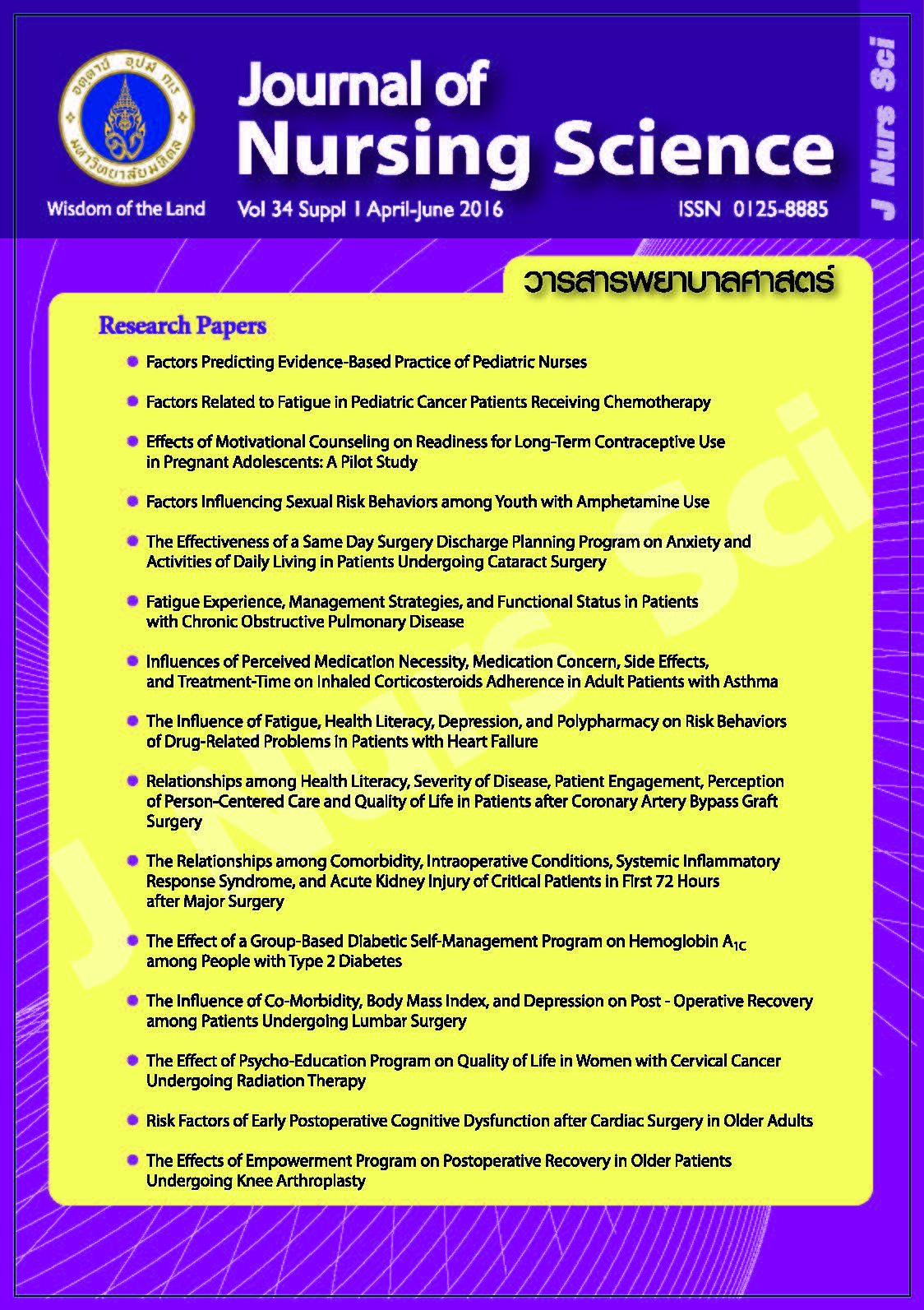Fatigue Experience, Management Strategies, and Functional Status in Patients with Chronic Obstructive Pulmonary Disease
Main Article Content
Abstract
Abstract
Purpose: This study aimed to study 1) fatigue experience, fatigue management strategies and functional status, 2) the relationship between fatigue experience and functional status, and 3) the relationship between outcome of fatigue management strategies and functional status in patients with chronic obstructive pulmonary disease.
Design: A descriptive correlational research.
Methods: The sample composed of 88 patients with chronic obstructive pulmonary disease who were treated at the respiratory disease clinic in one hospital in Samut Sakhon Province. Data were collected using 4 questionnaires: 1) demographic data record form, 2) the Revised Piper Fatigue Scale, 3) the management strategies, and 4) the Functional Performance Inventory. Data were analyzed with descriptive statistics and Pearson’s Product Moment Correlation Coefficient.
Main findings: Most of the subjects had low level of fatigue experience (M = 3.92, SD = 1.75). The most effective management strategy was taking short naps. The subjects had moderate to high overall functional status scores (M = 3.08, SD = .65). Fatigue experience was found to be
negatively correlated with functional status with statistical significance (r = .45, p < .05); but outcome of fatigue management strategies was not correlated with functional status (r = .16, p > .05).
Conclusion and recommendations: Nurses should concern fatigue experience and assist patients to management appropriately in order to promote functional status of those with chronic obstructive pulmonary disease.
ประสบการณ์การมีอาการอ่อนล้า กลวิธีการจัดการกับอาการและภาวะการทำหน้าที่ในผู้ป่วยโรคปอดอุดกั้นเรื้อรัง
บทคัดย่อ
วัตถุประสงค์: เพื่อศึกษา 1) ประสบการณ์การมีอาการอ่อนล้า กลวิธีการจัดการกับอาการ และภาวะการทำหน้าที่ 2) ความสัมพันธ์ระหว่างประสบการณ์การมีอาการอ่อนล้าและภาวะการทำหน้าที่ และ 3) ความสัมพันธ์ระหว่างผลของการจัดการอาการอ่อนล้าและภาวะการทำหน้าที่ในผู้ป่วยโรคปอดอุดกั้นเรื้อรัง
รูปแบบการวิจัย: การศึกษาความสัมพันธ์เชิงบรรยาย
วิธีดำเนินการวิจัย: กลุ่มตัวอย่าง คือ ผู้ป่วยโรคปอดอุดกั้นเรื้อรังจำนวน 88 คนที่เข้ารับการรักษาในคลินิกโรคระบบทางเดินหายใจ โรงพยาบาลแห่งหนึ่งในจังหวัดสมุทรสาคร เก็บข้อมูลโดยใช้แบบสอบถาม ประกอบด้วย 1) แบบบันทึกข้อมูลส่วนบุคคล 2) แบบประเมินประสบการณ์การมีอาการอ่อนล้า 3) แบบประเมินวิธีการจัดการกับอาการอ่อนล้าและ
ผลจากการจัดการกับอาการอ่อนล้า และ 4) แบบประเมินการทำหน้าที่ของผู้ป่วยโรคปอดอุดกั้นเรื้อรัง วิเคราะห์ข้อมูลด้วยสถิติเชิงพรรณนา และวิเคราะห์ความสัมพันธ์โดยใช้ค่าสัมประสิทธิ์สหสัมพันธ์เพียร์สัน
ผลการวิจัย: ประสบการณ์การมีอาการอ่อนล้าโดยรวมอยู่ในระดับเล็กน้อย (M = 3.92, SD = 1.75) กลวิธีการจัดการกับอาการอ่อนล้าที่กลุ่มตัวอย่างเลือกปฏิบัติและมีประสิทธิพลมากที่สุด ได้แก่ งีบหลับ หรือนอนหลับช่วงสั้นๆ คะแนนภาวะการทำหน้าที่โดยรวมอยู่ในระดับปานกลางค่อนข้างสูง (M = 3.08, SD = .65) ประสบการณ์อาการอ่อนล้ามีความสัมพันธ์เชิงลบกับภาวะการทำหน้าที่อย่างมีนัยสำคัญทางสถิติ (r = .45, p < .05) แต่ผลของการจัดการอาการอ่อนล้ากับภาวะการทำหน้าที่ไม่มีความสัมพันธ์กัน (r = .16, p > .05)
สรุปและข้อเสนอแนะ: พยาบาลควรตระหนักถึงอาการอ่อนล้าและช่วยเหลือให้ผู้ป่วยจัดการกับอาการอย่างเหมาะสม เพื่อส่งเสริมภาวะการทำหน้าที่ในผู้ป่วยโรคปอดอุดกั้นเรื้อรัง
คำสำคัญ: ประสบการณ์การมีอาการอ่อนล้า กลวิธีจัดการกับอาการอ่อนล้า ภาวะการทำหน้าที่ โรคปอดอุดกั้นเรื้อรัง
Article Details
Copyright Notice: Nursing Science Journal of Thailand has exclusive rights to publish and distribute the manuscript and all contents therein. Without the journal’s permission, the dissemination of the manuscript in another journal or online, and the reproduction of the manuscript for non-educational purpose are prohibited.

Disclaimer: The opinion expressed and figures provided in this journal, NSJT, are the sole responsibility of the authors. The editorial board bears no responsibility in this regard.


